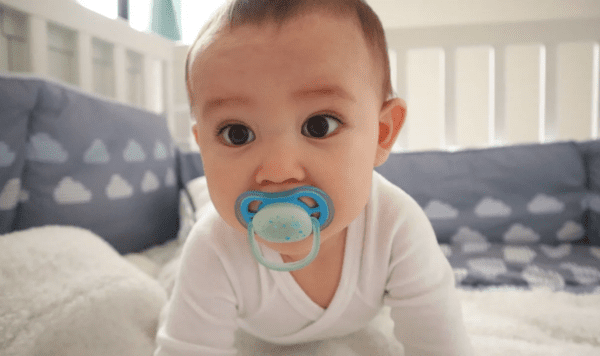Ali Weatherford
So many new parents rely on pacifiers to soothe their babies, but there is some controversy over whether to use them at all and how to use them. Just like so many things related to parenting, the very ambiguous answer is IT DEPENDS.
If you are a parent who has been relying on pacifiers and things are going well for you, great! In many cases, they can be used without any apparent negative consequences. On the other hand, some parents find that pacifiers can interfere with breastfeeding, or have issues later with getting their kids to quit the habit. Some parents regret using them at all when they’re struggling with the consequences.
We usually hear about the parenting wins, but don’t always hear about the regrets. This makes sense, if you really think about it. For most people, when they recognize they’ve made a mistake, broadcasting that mistake doesn’t sound fun. Most people don’t want to go around telling people about all the mistakes they’ve made and how they wish they had done things differently. Remember this for ALL things parenting related, so you can turn the volume down on all the loud voices telling you about how the way they are doing things is THE BEST WAY. You’re likely only hearing about the successes and not the failures.
How about breastfeeding and pacifiers?
From the perspective of breastfeeding professionals, pacifiers can definitely be a problem when not used properly. If you want to breastfeed exclusively, the recommendation is to wait to use a pacifier until breastfeeding is well-established.
To secure a good milk supply from the beginning, you want to feed your baby from the breast as often as possible. The more the breast is stimulated, the more your body understands the need to make milk. So, even if the baby is just suckling for comfort, that is actually helping to establish a good milk supply. If you introduce a pacifier early on, it could sometimes replace having the baby at the breast which can delay your milk production. If your baby seems fussy and you offer a pacifier, it might be that the baby is starting to feel hungry and the pacifier soothes them temporarily. That delays the feeding and can interfere with the milk-making.
In a recent policy statement, The American Academy of Pediatrics states that, “Implementation of breastfeeding-supportive hospital practices, including breastfeeding in the first hour after birth, exclusive breastfeeding, rooming-in, breastfeeding on demand, avoidance of pacifiers, and information on breastfeeding support after discharge, enabled women to be more successful at meeting their prenatal desire for exclusive breastfeeding.”
But once breastfeeding is well-established, a pacifier might be a good option for your baby and your family.
Benefits of pacifiers
Not all parents want to use pacifiers. Not all babies accept a pacifier. But when you are trying to decide about bringing a pacifier into the picture, know that there are some well-documented benefits to using them.
- When babies are allowed to suck on a pacifier for medical procedures, they show fewer signs of distress and pain.
- Pacifiers can be comforting, especially to babies 10 months of age and younger because they have strong sucking reflexes.
- Because of a baby’s natural desire to suck, a pacifier can be handy for busy or tired parents. Although the human nipple has been the most obvious choice for ages, sometimes a little technology can come in handy.
- There is also some evidence showing that the risk of SIDS can be reduced when babies use a pacifier for falling asleep. There is also a lower risk of SIDS with nighttime breastfeeding.
Risks of pacifier use
There can also be some downsides to using pacifiers, and those are increased with increased use. So, that means using them occasionally or very moderately might not be a problem, but the more a baby uses it, the riskier it gets. Some of the downsides include:
Dependence: A baby might get very dependent on the pacifier. Any pacifier-using parent understands the horror of a lost pacifier! A baby might be inconsolable and not be able to sleep, soothe, or cope without it. It also might be difficult to break the baby of the pacifier habit when you’re ready and can cause significant stress to the child and family.
Ear infections: Depending on how much the baby uses it and for how long, higher rates of otitis media (ear infections) can be associated with pacifier use.
Dental problems: There are many dental issues that pacifiers might get blamed for. Some of them are only likely with incorrect, excessive, or long term use (4+ years). Others such as changes in the dental arch or the baby’s bite are associated even with more moderate use of pacifiers.
How to use pacifiers
If you want to use a pacifier, and want to minimize the risks of using them, there are a few simple things to keep in mind:
- Wait until breastfeeding is well-established, especially if your goal is exclusive breastfeeding.
- To minimize pacifier use and potential for dependence, limit it for helping your baby fall asleep or in moments where you’re less able to comfort your baby in other ways.
- Try to wean your baby from the pacifier at around 10 months of age to minimize the risks for ear infections.
- Never sweeten a pacifier with sugar, corn syrup, or anything else. That can definitely contribute to dental problems, including cavities and gum disease.
- ONLY use good quality pacifiers that are designed for that purpose. Don’t try to make up your own pacifier or get low quality or used pacifiers. There have been cases of infant deaths caused by bad pacifiers.
- Use pacifiers made with safe materials to minimize the risks that can occur with certain plastics and chemicals.
Inspect and change pacifiers often. Make sure there aren’t any cracks, breaks, or tears in the pacifier that might be pulled off and become a choking hazard.
References

